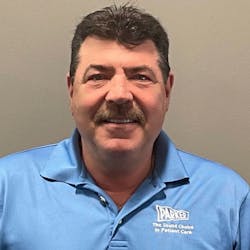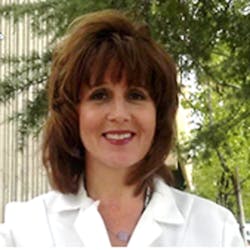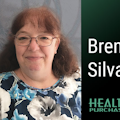Infection prevention challenges require new solutions
As hospitals and healthcare facilities look to meet the daily demands of infection prevention (IP) protocols, many face the additional challenges of inadequate information, incomplete training, and insufficient staff. Unfortunately, one side-effect of these challenges is often a decreased efficacy of cleaning practices, which can potentially lead to an increase in hospital-acquired infections (HAIs). By all assessments, the medical industry needs improved options to overcome the challenges of air/surface cleaning and disinfection.
In response to the need for improved IP solutions, many industry experts agree that the most effective product currently available for ridding facilities of bacterial and viral microbes is a solution made up of 100% education.
Increased education and decreased infections
In order to meet established infection prevention protocols, hospitals and healthcare facilities must first understand that not all cleaning and disinfection products are equal. There is no one-size-fits-all when it comes to disinfecting air and surface locations, and different areas often require different cleaning products. This is where product education for C-suite executives and decision-makers is most vital. Products purchased without thorough knowledge of their intended use can lead to ineffective cleaning practices, and an increased opportunity for microbes to thrive.
“One of the biggest challenges facing hospitals today is that environmental services (EVS) team members don't have the right tools to accomplish their job. Harmful pathogens remain on commonly touched surfaces, even after the best liquid chemical cleaning efforts. Studies show that less than half the surfaces in a hospital room are properly disinfected after manual cleaning when the room is being prepared for the next patient.”
He continued, “With the growing number of HAIs, resistant pathogens, viral variants from our last pandemic, and potential future pandemics including Ebola that can and will hit healthcare facilities worldwide, facilities are turning towards a wider variety of chemicals and methods to find a solution, and often with damaging results. It can prove to be a minefield at times – some disinfectants achieve the kill, but corrode and damage expensive surfaces. Others seem gentle on surfaces, but either need to stay wet for hours or compromise on the results. Either way, healthcare facilities are gambling with their ratings, budgets, funding, patient and personnel health, and so much more.”
“I think one of the biggest problems facilities have with surface disinfection is knowing the cleaning instructions for all of the equipment in the facility. A lot of facilities want to use one product that kills everything; however, some of these disinfectants are very harsh, and destroy sensitive equipment and vinyl surfaces as well. There are many products out there that will work for most surfaces, but there is not one product on the market that will work for all surfaces.”
“I see a great challenge in continuously educating decision-makers to ensure that they are selecting the appropriate solution for infection control, and training staff to implement a disinfection protocol, as well as use the product correctly. For example, using a disinfectant product or system that does not have a 6-log kill of spores in a C. diff isolation room will not achieve effective disinfection of that space.”
Insufficient staff and incomplete training
Along with thorough infection prevention product knowledge for all staff members, lies the equally troubling challenge of simply not having enough staff to train. Without the necessary staff to properly clean and disinfect microbe-laden areas of a hospital or healthcare facility, existing staff and teams become stretched thin through added duties that cover multiple areas. The lack of staff also means that the length of product education and usage training can become shortened, resulting in “just the basics” instruction that often leads to ineffective cleaning and disinfection of vital areas, as well as patient safety concerns.
“Healthcare providers continue to face a number of challenges that impact their ability to effectively and efficiently execute cleaning and disinfecting protocols to help prevent the spread of pathogens that can cause illness, particularly healthcare-associated infections (HAIs). One challenge that continues to persist is staffing burnout and/or shortages, as well as high employee turnover. High employee turnover, coupled with staffing shortages, result in heightened concern around patient safety, including HAI-prevention, as well as a training gap because facilities have limited time to provide adequate and effective training to new employees.”
She continued, “Training is essential for ensuring cleaning and disinfecting protocols are executed efficiently, effectively, and safely to help combat the spread of pathogens including HAIs. To ensure new staff receive the knowledge and skills needed, as well as help previous staff remain current with their education, facilities should look to leverage online, on-demand education solutions that take the guesswork out of training, such as the CloroxPro HealthyClean online learning platform.”
Accredited by American National Standards Institute National Accreditation Board (ANAB), HealthyClean is the only industry-wide certificate course designed for the commercial cleaning industry.
Within the infection prevention industry, many experts would agree that with the proper amount of time spent on education and training prior to product use, cleaning and disinfection products can be as effective as they are intended.
Parker Labs’ Rodenberg suggested, “Infection control should check with the manufacturers of equipment on recommendations for disinfectants, so as to minimize damage to expensive equipment due to the wrong choice in a disinfectant. The instructions for use (IFUs) for the disinfectants vary, and the users should know the application instructions and required time. Additionally, high-alcohol wipes may not apply enough liquid to wet the surface for long enough without multiple applications.”
Infection prevention and industry prognosis
Along with challenges of infection prevention product education and staff training, the issue of high patient throughput is also having an impact on cleaning and disinfection protocols. The increased patient throughput has placed increased demands on disinfection turnaround times in both patient rooms and surgery-related areas. Infection prevention and EVS teams are under heightened pressure to get rooms cleaned, disinfected, and ready for the next patient’s use much faster than in the past. The result of these increased demands is ineffective infection prevention, which, once again, can lead to issues of patient and staff safety.
Looking to a prognosis for infection prevention best practices, industry experts are quick to suggest solutions that may help streamline cleaning and disinfection procedures, while meeting EPA-dictated and established protocols.
SteraMist’s Dr. Shane acknowledged, “The healthcare industry has been doing its best to leave manual cleaning behind, while trending towards proven no-touch solutions for a wide variety of reasons. There will always be a need to address pathogens on surfaces, but when it comes to fighting the invisible, facilities are turning to disinfection such as ultraviolet (UV) lights, electrostatic sprayers, types of disinfecting waters, and foggers like SteraMist.”
He continued, “Cleaning and preparedness protocols are advancing rapidly, and IPs are becoming keenly aware that something more is needed. UV has increasingly come under scrutiny for lackluster results, destruction of plastics, line of sight, and skyrocketing maintenance costs. Electrostatic sprayers are falling short as well, with many vaguely defined quat solutions on the market introducing unnecessary dangers into the facility environment.”
He summed up, “As far as a solution for disinfection, the answer lies in how hospitals are becoming more aware of what to look for to suit their unique needs, rather than simply changing technologies on the market. As a result, technologies should be as adaptable as they are innovative. The future is in technology and I can see hospitals building ionized hydrogen peroxide (iHP) technology into their facilities, enabling the building, room or area to be disinfected with the push of a button.”
Extolling the benefits of UV as a pathogen-killing option, Xenex’s Stibich reported, “A common challenge we hear is about hospital throughput. Censuses are high and the EVS team faces incredible pressure to get rooms cleaned and ready for the next patient. That's why quick disinfection cycle times are important.”
Within the UV space, Xenex’s LightStrike robots feature two-to-five-minute disinfection cycles (depending on the pathogen being targeted), allowing hospitals and healthcare facilities to disinfect dozens of rooms per day, per robot.
Stibich added, “As hospitals recover from the pandemic and the incredible stresses they faced, they are refocusing on known pathogens (like C.diff and MRSA), as well as being on alert for pathogens we'll face in the future. Antimicrobial resistance (AMR) is a real threat, and destroying the pathogens before they develop resistance is an incredibly important step.”
Also in the UV industry is UltraViolet Devices, Inc. (UVDI), based in Santa Clarita, CA, where the challenges of air/surface cleaning and disinfection are acknowledged, and UV lamp solutions are geared toward increased effectiveness in room disinfection, purification, and sterilization.
He explained, “For UV room disinfection devices, key criteria to consider are: (1) is a device’s effectiveness against high-risk microorganisms independently proven at real-world times and distances; (2) Can it disinfect an average-sized room quickly enabling fast room turnover across entire units; (3) is it easy to operate with simple on-and-off device controls; and (4) does it contain advanced features like smart communications technology for automatic device data transmission and health notifications (which is a labor-saver in itself)?”
Even with increased patient turnover rates and heightened demands for faster room disinfection, there still remains a need for regulatory guidance on which disinfectants are the most effective for existing and emerging pathogens. Halosil’s St. Clair detailed recent EPA regulations and methodology for communicating guidance for disinfectant efficacy.
“Several months ago, the EPA (the U.S. regulator of antimicrobial disinfectants) updated their methodology for communicating their guidance for which disinfectants are effective for use against rarely encountered and emerging (new) pathogens (EVP). This new list format differs from other lists previously published by EPA, which address individual pathogens. List Q facilitates the search of all products eligible for use against any of the three main categories of EVPs grouped by their difficulty to inactivate — Tier 1: enveloped viruses (easiest to inactivate), Tier 2: large, nonenveloped viruses (more difficult to inactivate), and Tier 3: small, nonenveloped viruses (hardest to inactivate).”
She continued, “This methodology simplifies the information, and obviates the need to continuously create new lists as pathogens emerge. In the future, environmental service managers and infection preventionists can select disinfectants accordingly.”
Halosil’s HaloMist hydrogen peroxide-based disinfectant has been listed as a fogging formulation on EPA’s List Q and meets the guidance for effective use against all three tiers of viruses when applied with the HaloFogger following the use instructions for Clostridioides difficile, a spore-forming organism.
Another option for effective infection prevention is the employment of ready-to-use (RTU) products, which can help streamline cleaning and disinfection procedures.
Clorox’s Kley elaborated, “Amidst staffing shortages and burnout, optimization is key. Healthcare facilities should also look to the type of products they are using to streamline efforts. For example, ready-to-use (RTU), one-step cleaner disinfectants can not only save staff time, but can also eliminate the risk of dilution errors that can potentially lead to the spread of HAIs. Ready-to-use products also help reduce cross-contamination risks, quality control (QC) issues, and low compliance, leading to overall increases in efficacy and efficiency.”
She summed up, “Through proper training and the use of efficient strategies, like ready-to-use disinfectants, I believe facilities can successfully improve HAI prevention protocols to effectively remove the environment as a source of infection, despite current staffing challenges.”







